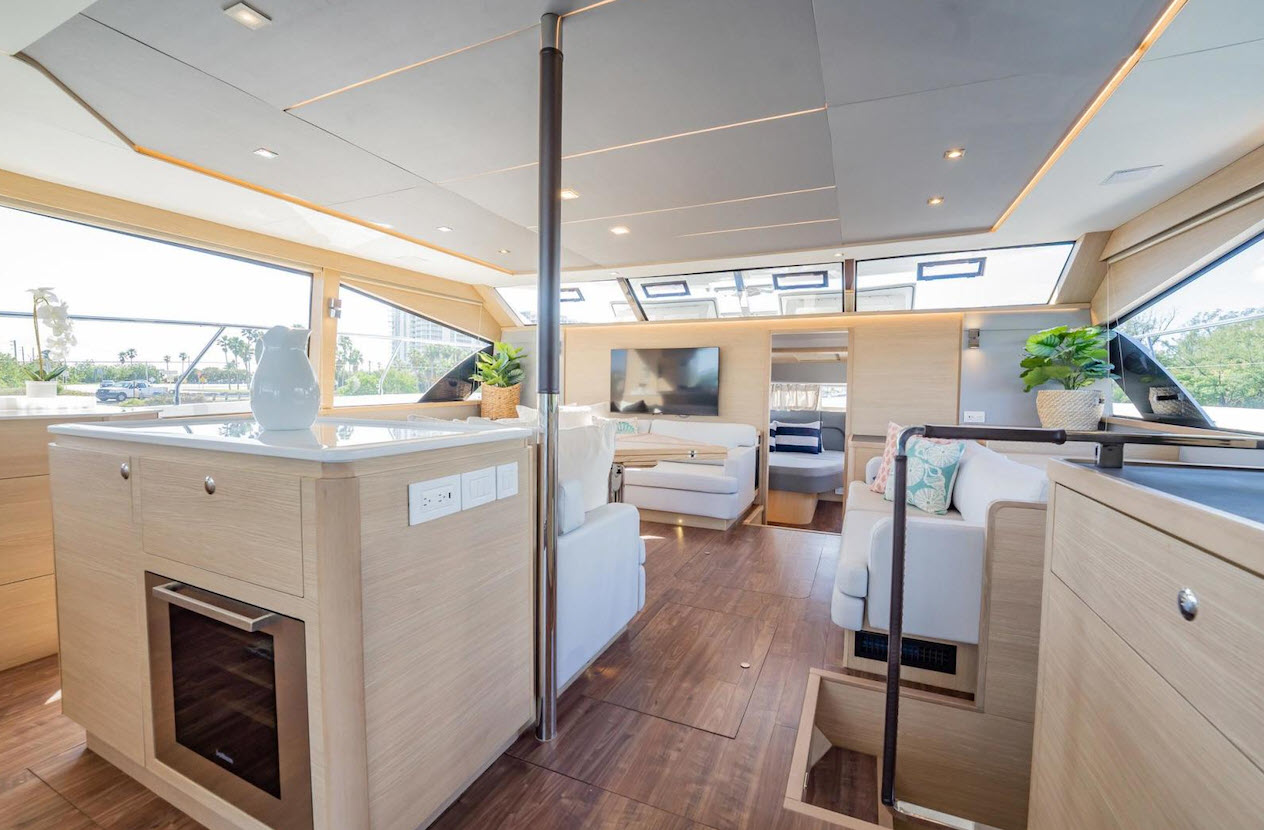
Are Power Catamarans Good In Rough Water?
Anyone that’s ever been caught on the water when a summer storm rolls up and the wind starts to blow has experienced a choppy ride back to the dock. Some boat builders perform better than others. Some types of boats perform better than others. While a little chop in a 40-foot center-console might not mean too much to the captain and guests on board, those in a luxury yacht might feel differently. Expensive furniture, cutlery, glassware, luggage, and whatever isn’t secured down can often be tossed around the interior, leaving a mess for the captain or crew to clean up.
If you’re searching for the right boat to keep things stable while on the ocean, the old adage of two is better than one definitely applies. Multihull boats are widely known to be a more stable platform while cruising, along with several other benefits. And the growth of ownership and popularity has substantially increased as well, with catamaran sales expected to rise to more than $2.2 billion by 2030! Many sailboat owners are beginning to ditch the effort it takes to enjoy boating and opting instead for power catamarans.
But are power catamarans really good in rough water? Certified professional yacht broker and power catamaran expert Brian Franc says “Yes!”. “Based on my experiences and those of my clients, power catamarans perform very well in rough water,” says Brian. “Multihull boats tend to be far more stable than monohulls due to the displacement across a much wider beam. This allows less water to be in contact with the twin hulls, offering more buoyancy.” The result is that the power catamaran goes over the waves instead of through them, increasing stability and safety in rougher waters.
(Below: While this Freeman Boat has a multihull design, it uses outboards instead of traditional power cat inboard diesel engines. The performance of the hull is still the same though, as seen here while going through rough seas at Haulover Inlet.)
OTHER BENEFITS OF THE POWER CATAMARAN DESIGN
Aside from the advantage of being a very stable boat, the power catamaran design also has several other benefits for the owner in terms of performance. Of course, if you get any boat into 10-foot waves, there are going to be major problems, but we are assuming no one is going to be out boating in those conditions. For the purpose of answering the question of how power cats perform in rough seas, we are assuming waves of 6-feet or less.
Here are several other advantages that power catamarans have over traditional monohull boats.
- Power Cats Have Less Draft – Want to cruise the islands? Better be careful in traditional monohull yachts that have more of a draft. Because catamarans rely on buoyancy from their dual hulls, they require less water to float and sit higher on the water.
- Faster Than Sailboats, Sailing Cats, & Some Monohull Yachts – If you’re moving into a power catamaran from a sailboat or a sailing catamaran, the twin engines will be a welcomed feature. Being able to get up to a 20 knots cruise means outrunning storms!
- Catamarans Are Easier To Maneuver – Thanks to being lighter in weight and having dual engines, maneuvering in rough seas or in a crowded area (like at a marina) becomes a little easier for a power catamaran owner. Add in the latest joystick technology and you can cruise with confidence.
- Power Catamarans Are More Fuel Efficient – Burn less fuel and spend less money with a power catamaran. Thanks to less drag and resistance, along with no sudden spikes in fuel consumption, power cats are well-known to be more efficient.
- Massive Accommodations And Living Spaces – Let’s face it, you can simply do more with more space and it’s tough to match the interior volume of a boat with a 20-foot beam or more. Power Catamarans are known for incredible space in the bedrooms, as well as the salon and galley.
(Below: The interior of this Aquila Boats 54, listed with Brian Franc, offers a tremendous amount of volume thanks to its 25′ 2″ beam.)
WHAT ARE THE DOWNSIDES TO OWNING A POWER CATAMARAN?
Easily the biggest downside to owning a power catamaran has nothing to do with its design, performance, or accommodations. It’s where to put it. Most marinas have very limited space on where they can tie up a boat with a 25′ beam as it takes up significantly more space than a monohull. Generally power catamarans are put at the end of the T-dock, which means there are less spaces available. Of course, if you are buying a power catamaran and putting it behind your house or into a charter program, this doesn’t matter, but if you plan to rent a space at a marina, we suggest you work with your yacht broker to find storage.
(Below: Brian Franc’s Aquila 54 – not in rough water, but looking good nonetheless.)
United Yacht Sales has the world’s largest network of boat buyers and sellers in the industry, thanks to our team of over 250 yacht brokers in 104 different locations. Whether buying a luxury boat or selling one, we have the right expert on staff to assist you in navigating the brokerage market for your type of yacht. If you’re looking at selling a boat, there is no quicker way to get activity than listing it with United. Our entire team is immediately notified every time a listing agreement is made with United Yacht Sales and many boats are sold before they ever even make it online. Our support team is among the best in the industry at marketing your yacht. 100% of our marketing budget goes towards advertising our clients’ listings, a claim not many other firms can make. To get started listing your yacht, fill out our online form What’s My Yacht Worth?
Also Read: Who Makes The Best Power Catamaran?
Interesting Boating Links
Worldwide Yacht Sales
Luxury Boats & Yachts
Popular Builders & Models
"*" indicates required fields
Share this with




